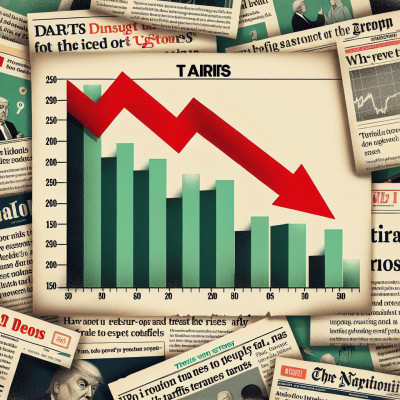
Markets Tumble as Tariff Uncertainty Roils Wall Street
The S&P 500 experienced a significant downturn on Tuesday, March 8, 2025, closing the trading day with a steep 1.6% loss. Investors turned cautious as looming tariff concerns and international trade tensions overshadowed the day’s early gains. The drop marked one of the sharpest daily losses of the year, underscoring the fragility of market confidence in the face of global economic uncertainty.
Early Gains Fade Amid Rising Trade Tensions
Wall Street opened the day on a positive note, buoyed by optimism surrounding corporate earnings and better-than-expected U.S. economic data. However, that momentum quickly reversed as fresh headlines reignited investor fears about a new round of tariffs potentially impacting key sectors of the economy.
Reports suggest that tariffs on imported goods from major trading partners may increase as early as next week, affecting industries ranging from technology to consumer goods. Concerns over the economic impact of such policy shifts drove a broad-based selloff, dragging down major indexes and reversing early-session optimism.
Sectors Most Affected by Tariff Concerns
The sell-off was not evenly distributed across all sectors. Instead, certain industries bore the brunt of the market’s reaction:
- Technology: Often sensitive to international trade policy, tech stocks led the declines as fears mounted over potential supply chain disruptions and increased costs for components.
- Consumer Discretionary: Companies that rely on international manufacturing or that sell heavily in global markets saw steep drops amid concerns about shrinking profit margins.
- Automotive: Tariffs on imported parts or entire vehicles could significantly alter the cost structures of auto manufacturers, sending shares lower.
Investors moved quickly to offload their more cyclical holdings, seeking shelter in traditionally safer assets such as utilities and healthcare. However, the breadth of Tuesday’s decline meant that even these sectors were not immune to the day’s volatility.
Investor Sentiment Slips as Global Outlook Worsens
Investor sentiment has been on edge in recent months amid mixed economic signals, persistent inflationary pressures, and cautious central bank messaging. The new tariff threats added another layer of uncertainty to an already jittery market landscape.
Market analysts point out that sentiment is shifting from resilience to risk-aversion. With global supply chains still recovering from the pandemic-era disruptions, fresh tariffs could hinder progress and prompt revisits to already tight earnings guidance.
Global Markets Respond in Kind
U.S. equity weakness echoed across global markets as well. Major indices in Europe and Asia also registered losses on the day, with particular softness in export-heavy markets such as Germany and South Korea. The ripple effects of U.S. trade policy decisions continue to resonate globally, impacting not just multinational companies but also entire economies dependent on trade with the United States.
What This Means for Investors Going Forward
Tuesday’s reversal serves as a stark reminder for investors that geopolitical developments, especially those involving trade, can have swift and sweeping impacts on financial markets. While many fundamentals remain strong — including a robust labor market and improving corporate earnings — trade policy uncertainty creates headwinds that are difficult to quantify.
Key takeaways for investors:
- Monitor Policy Announcements: Staying abreast of international developments will be crucial, especially as government officials hint at new trade measures in the coming weeks.
- Diversification Remains Critical: Broad exposure across sectors and geographies may help mitigate volatility stemming from trade shocks.
- Safe-Haven Assets May See Renewed Interest: In times of increased uncertainty, exposure to government bonds, gold, or defensive stocks may help reduce downside risk.
Conclusion: A Wake-Up Call for Markets
The 1.6% drop in the S&P 500 on March 8, 2025, is more than just a one-day pullback — it is a reflection of how vulnerable markets can be to abrupt policy shifts. As investors navigate the uncertain terrain of tariffs and trade disputes, balancing optimism with caution will be essential. The coming weeks could be pivotal in determining whether this market reaction is an isolated event or the beginning of a more sustained period of volatility.
While long-term investors may see this as a possible buying opportunity, those with shorter time horizons should brace for continued turbulence as more information about the potential tariffs unfolds. As always, maintaining a disciplined investment approach and consulting with financial advisors is recommended during uncertain times.


Leave a Reply